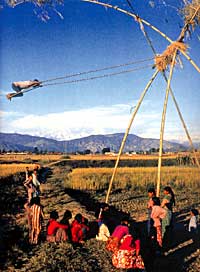 It is said Nepali culture demands bamboo from birth to death and everything in between. We use bamboo as scaffolding material, as food, for music, to carry things and to write with. Nepal has over 50 species of bamboo. Another 10 species are in the process of being classified. Most Nepali bamboo types are found in the wetter middle and eastern regions of Nepal from 50m-4,000m, with Ilam, Dhankuta, Bhojpur and Taplejung having the sturdiest stems.
It is said Nepali culture demands bamboo from birth to death and everything in between. We use bamboo as scaffolding material, as food, for music, to carry things and to write with. Nepal has over 50 species of bamboo. Another 10 species are in the process of being classified. Most Nepali bamboo types are found in the wetter middle and eastern regions of Nepal from 50m-4,000m, with Ilam, Dhankuta, Bhojpur and Taplejung having the sturdiest stems. This is great diversity for country our size, says our foremost expert on this woody grass, Annapurna Das. "Nepal has up to five percent of the world's bamboo population, within only 0.1 percent of the world's land area," says Das, who is the only Nepali with a PhD in bamboo.
Another of Nepal's foremost experts on the plant is Shyam K Paudel, who is based in Beijing with the International Network for Bamboo and Rattan (INBAR). A forester by training, Paudel has been in China since 2002, looking at bamboo's potential for rural enterprise and poverty alleviation. One hectare of bamboo can earn a farmer up to Rs 400,000 annually, says Paudel, adding: "Bamboo is a natural tool that encourages sustainable, integrated farming systems and is an excellent resource for income and employment generation." The beauty of bamboo is that it is fast-growing, needs little maintenance, can grow on forest margins and requires only modest investment.
Some communities in Nepal, like the Dom Dalits in the tarai who number only 20,000, are completely dependant on the bamboo, making their living from weaving mats from nigalo. Many Rai and Limbu communities in the east also rely on bamboo, and are expert weavers of doko and dalo for the local market.
Bamboo has finally been recognised as an 'international commodity' and is now under the purview of the International Commodity Body. And international conference in New Delhi next week will be looking at expanding bamboo trade. "Nepal can be a key player in the international bamboo and cane trade which averages $6 billion annually," Paudel says.
In terms of quality, Nepali bamboo is as good as, if not better than most. And we are still finding new uses for this versatile plant. For instance, bamboo is the best 'carbon sink' for greenhouse gases putting out 35 percent more oxygen than other trees and every hectare of bamboo soaks up 12 tons of carbon dioxide every year. "We should all consider living in a bamboo jungle," Das says, and he doesn't seem to be joking.
 Food
Food For the Japanese, Taiwanese, Chinese, Thai, and Nepalis bamboo shoots are a staple diet. Nepal produces 102 tons of tama and each household consumes about 46 stems a year. It is a good source of fibre, carbohydrate, vegetable fat, protein and vitamin B.
Timber
Strong but flexible and incredibly versatile, bamboo is an excellent alternative to wood. With a tensile strength of 28,000 per square inch, it's even a stronger building material than steel. "Harvestable in three years for building, bamboo homes only need an eighth of the energy concrete requires to create building material with the same capacity," marvels Paudel. To top it off, it is also the quickest growing plant in the world, growing 30 percent quicker than the fastest growing tree. This capacity to regenerate and its yields, which can be up to 25 times more than timber when well managed makes bamboo an environmentally sound choice. Bamboo homes, light and elastic, are also earthquake resistant.
Green
In a country as vertical as Nepal, bamboo is also great for soil conservation. Growing in mixed cultures, it is naturally less likely to cause soil erosion than monocultural farming. "Bamboo creates a mat-like structure underground, effectively stitching the soil together, it is perfect for fragile river banks, deforested areas, earthquake zones and preventing mud slides," says Das.
Paper
Bamboo has been used for making paper since the 2nd century. At one point, this renewable resource was used to make 70 per cent of India's paper.
Medicine
Ancient Ayurvedic and Chinese healing traditions have used the medicinal properties of bamboo. In acupuncture, bamboo secretion is powdered and hardened and used internally to treat asthma, coughs and as an aphrodisiac. Black bamboo root is used to treat kidney disease. In Ayurveda, bamboo manna is a rejuvenating herb for sore throats.
The 7th World Bamboo Congress will be held 27 February-4 March, 2004 at New Delhi www.worldbamboocongress.com


